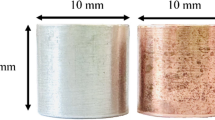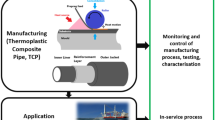Abstract
This paper explores the possibility of producing an improved interference-fit tubular joint between pure copper and stainless steel tube by electromagnetic crimping (EMC). Successful joints are obtained with optimal parameters consisting of the outer surface profile of the inner tube and discharge energy. Joints exceeding the strength of the parent tube are formed without any metallic bond formation. Three destructive testings, namely, pull-out, compression and torsion tests, have confirmed the successful joint formation as the failure occurs in the copper base tube. Analysis of failure mechanisms has revealed joint behaviour at various discharge energies and surface profiles. Among smooth, knurled and threaded surface profiles with different discharge energy levels, knurled surface provides best joint strength at 6.2 kJ, which has shown a failure in the parent Cu tube during all three destructive testings. Radial deformation of the tubes is measured and compared for different discharge energy and surface profile. No metallic bond formation and the wavy interface are observed between the joining partners during microstructural analysis. Furthermore, no elemental overlapping is observed during energy dispersive spectroscopy mapping analysis indicating an absence of diffusion. Higher micro-hardness is observed near the Cu-SS tubular joint interface due to strain hardening caused by high-velocity impact.































Similar content being viewed by others
References
Matsuzaki R, Kanatani T, Todoroki A (2019) Multi-material additive manufacturing of polymers and metals using fused filament fabrication and electroforming. Addit Manuf 29:100812
Matsuzaki R, Shibata M, Todoroki A (2008) Improving performance of GFRP/aluminum single lap joints using bolted/co-cured hybrid method. Compos A: Appl Sci Manuf 39(2):154–163, ISSN 1359-835X. https://doi.org/10.1016/j.compositesa.2007.11.009
Simoen B, Faes K, Waele WD (2017) Investigation of the weldability of copper to steel tubes using the electromagnetic welding process. Int J Sustain Constr Des 8. https://doi.org/10.21825/scad.v8i1.6811
Raoelisona RN, Sapanathan T, Buiron N, Rachik M (2015) Magnetic pulse welding of Al/Al and Al/Cu metal pairs: consequences of the dissimilar combination on the interfacial behavior during the welding process. J Manuf Process 20:112–127. https://doi.org/10.1016/j.jmapro.2015.09.003
Patra S, Arora K, Shome M, Bysakh S (2017) Interface characteristics and performance of magnetic pulse welded copper-steel tubes. J Mater Process Technol 245:278–286. https://doi.org/10.1016/j.jmatprotec.2017.03.001
Massalki TB, Murray JL, Bennet LH, Baker H, Kacprzak L (1986) Binary alloy phase diagrams, vol Vols. 1 and 2. American Society for Metals, Metals Park
Oliveira IV, Cavaleiro AJ, Taber GA, Reis A (2017) Magnetic pulse welding of dissimilar materials: aluminum-copper. In: Silva L (ed) Materials Design and Applications, Advanced Structured Materials, vol 65. Springer, Cham, pp 419–431. https://doi.org/10.1007/978-3-319-50784-2_31
Pereira D, Oliveira JP, Pardal T, Miranda RM, Santos TG Magnetic pulse welding: machine optimisation for aluminium tubular joints production. In: Science and Technology of Welding and Joining, VL - 23, IS - 2. Taylor & Francis, SN - 1362-1718. https://doi.org/10.1080/13621718.2017.1355425
Pereira D, Oliveira JP, Santos TG, Miranda RM, Lourenço F, Gumpinger J, Bellarosa R (2019) Aluminium to Carbon Fibre Reinforced Polymer tubes joints produced by magnetic pulse welding. Compos Struct 230:111512, ISSN 0263-8223. https://doi.org/10.1016/j.compstruct.2019.111512
Aizawa T, Kashani M, Okagawa K (2007) Application of magnetic pulse welding for aluminum alloys and SPCC steel sheet joints. Am Weld J 86:119–124
Weddeling C, Demir O, Haupt P, Tekkaya A (2015) Analytical methodology for the process design of electromagnetic crimping. J Mater Process Technol 222:163–180. https://doi.org/10.1016/j.jmatprotec.2015.02.042
Park Y, Kim H, Oh S (2005) Design of axial/torque joint made by electromagnetic forming. Thin-Walled Struct 43:826–844. https://doi.org/10.1016/j.tws.2004.10.009
Kumar D, Kore SD, Nandy A (2020) Finite element modeling of electromagnetic crimping of Cu-SS tube-to-tube joint along with simulation of destructive testing for strength prediction of the joint. ASME J Manuf Sci Eng 143(4):041004. https://doi.org/10.1115/1.4048431
Rajak A, Kore SD (2017) Experimental investigation of aluminium–copper wire crimping with electromagnetic process: Its advantages over conventional process. J Manuf Process 26:57–66. https://doi.org/10.1016/j.jmapro.2017.01.009
Weddeling C, Woodward S, Marré M, Nellesen J, Psyk V, Tekkaya AE, Tillmann W (2011) Influence of groove characteristics on strength of form-fit joints. J Mater Process Technol 211:925–935. https://doi.org/10.1016/j.jmatprotec.2010.08.004
Pawar SH, Ray D, Kore SD, Nandy A (2020) Electromagnetic forming and perforation of tubes: modeling, simulation and validation. ASME J Manuf Sci Eng 143. https://doi.org/10.1115/1.4049090
Pawar S, Kore SD, Nandy A (2019) Magnetic pulse forming and punching of Al tubes—a novel technique for forming and perforation of tubes. In: Shunmugam M, Kanthababu M (eds) Advances in Forming, Machining and Automation. Lecture Notes on Multidisciplinary Industrial Engineering. Springer, Singapore. https://doi.org/10.1007/978-981-32-9417-2_5
Pawar S, Kore SD, Nandy A (2020) Comparison of sheared edge zones developed in electromagnetic and quasistatic dieless perforation. J Mater Eng Perform 29:1146–1155. https://doi.org/10.1007/s11665-020-04636-w
Eguia I, Zhang P, Daehn GS (2004) Improved Crimp-Joining of Aluminum Tubes onto Mandrels with Undulating Surfaces. In: Proceedings of the 1st International Conference on High Speed Forming ICHSF 2004, Dortmund, Germany, pp 161–170. https://doi.org/10.17877/DE290R-12974
Kumar D, Pawar S, Kore SD, Nandy A (2020) Comparison of coupled and non-coupled finite element models for joining of Cu-SS tubes by electromagnetic forming. Procedia Manuf 47:673–677. https://doi.org/10.1016/j.promfg.2020.04.208
Kumar D, Kore SD, Nandy A (2021) Finite element modelling of electromagnetic crimping of copper-stainless steel tube-to-tube joint. In: Pandey K, Misra R, Patowari P, Dixit U (eds) Recent Advances in Mechanical Engineering. Lecture Notes in Mechanical Engineering. Springer, Singapore. https://doi.org/10.1007/978-981-15-7711-6_11
Fan Z, Yu H, Li C (2016) Plastic deformation behavior of bi-metal tubes during magnetic pulsecladding: FE analysis and experiments. J Mater Process Technol 229:230–243. https://doi.org/10.1016/j.jmatprotec.2015.09.021
Bahmani M, Niayesh K, Karimi A (2009) 3D Simulation of magnetic field distribution in electromagnetic forming systems with field-shaper. J Mater Process Technol 209:2295–2301. https://doi.org/10.1016/j.jmatprotec.2008.05.024
Psyk V, Risch D, Kinsey B, Tekkaya A, Kleiner M (2011) Electromagnetic forming - a review. J Mater Process Technol 211:787–829. https://doi.org/10.1016/j.jmatprotec.2010.12.012
Kleiner M, Brosius A (2006) Determination of flow curves at high strain rates using the electromagnetic forming process and an iterative finite element simulation scheme. CIRP Ann 55:267–270. https://doi.org/10.1016/S0007-8506(07)60413-2
Messler RW Jr (1995) Joining of advanced materials. SAMPE J 31:25–30
Marre M (2009) Grundlagen der Prozessgestaltung für das Fügen. Dortmund (Dr.-Ing. Thesis): Institut für umformtechnik und leichtbau, Technischen Universität Dortmund. https://doi.org/10.17877/DE290R-8305
Hammers T, Marré M, Rautenberg J, Barreiro P, Schulze V, Biermann D, Brosius A, Tekkaya AE (2008) Influence of mandrel’s surface and material on the mechanical properties of joints produced by electromagnetic compression. In: Proceedings of the 3rd International Conference on High Speed Forming ICHSF 2008, Dortmund, Germany, pp 245–256. https://doi.org/10.2374/SRI08SP151
Belyy IV, Fertik SM, Khimenko LT (1977) Spravochnik Po Magnitnoimpulsnoy Obrabotke Metallov (Electromagnetic Metal Forming Handbook). English Translation by Altynova, M. M., available at: http://www.mse.eng.ohiostateedu/_Daehn/metalforminghb/index.html. Accessed 21 May 2019
ASTM International (2016) E8/E8M-16a Standard test methods for tension testing of metallic materials. West Conshohocken. https://doi.org/10.1520/E0008_E0008M-16A
Faes K, Waele WD, Müller M, Cramer H (2014) Design of electromagnetic pulse crimp torque joints. In: Proceedings of the 6th International Conference on High Sped Forming ICHSF 2014, Daejon, Korea, pp 39–50
Fazzolari FA (2017) 2 - Sandwich Structures. In: Abramovich H (ed) Stability and vibrations of thin walled composite structures. woodhead publishing, pp 49–90, ISBN 9780081004104. https://doi.org/10.1016/B978-0-08-100410-4.00002-8
Rosato D, Rosato D (2003) 4 - PRODUCT DESIGN. In: Rosato D, Rosato D (eds) Plastics Engineered Product Design. Elsevier Science, pp 198–343. https://doi.org/10.1016/B978-185617416-9/50005-3
Kleiner M, Marré M, Beerwald C, Homberg W, Löhe D, Barreiro P, Schulze V (2006) Investigation of force-fit joints produced by electromagnetic tube compression. Annals of the German Academic Society for Production Engineering WGP XIII: 227–230
Xu Z, Cui J, Yu H, Li C (2013) Research on the impact velocity of magnetic impulse welding of pipe fitting. Mater Des 49:736–745, ISSN 0261-3069. https://doi.org/10.1016/j.matdes.2012.12.059
Kore SD, Date PP, Kulkarni SV, Kumar S, Rani D, Kulkarni MR, Desai SV, Rajawat RK, Nagesh KV, Chakravarty DP (2011) Application of electromagnetic impact technique for welding copper-to-stainless steel sheets. Int J Adv Manuf Technol 54:949–955. https://doi.org/10.1007/s00170-010-2981-z
Abdulhadi HA, Aqida SN, Ismail I (2019) Tool Failure in Die Casting, Reference Module in Materials Science and Materials Engineering. Elsevier, ISBN 9780128035818. https://doi.org/10.1016/B978-0-12-803581-8.10483-7
Kumar R, Kore SD (2017) Effects of surface profiles on the joint formation during magnetic pulse crimping in tube-to-rod configuration. Int J Precis Eng Manuf 18:1181–1188. https://doi.org/10.1007/s12541-017-0138-9
Acknowledgements
The authors are grateful to the SERB, DST, India for supporting this research under Project (IMP/2019/000276) and for Research scholarship from MHRD, India.
Author information
Authors and Affiliations
Corresponding author
Additional information
Publisher’s note
Springer Nature remains neutral with regard to jurisdictional claims in published maps and institutional affiliations.
Recommended for publication by Commission XI - Pressure Vessels, Boilers, and Pipelines
Rights and permissions
About this article
Cite this article
Kumar, D., Kore, S.D. & Nandy, A. Interference-fit joining of Cu-SS composite tubes by electromagnetic crimping for different surface profiles. Weld World 65, 1031–1050 (2021). https://doi.org/10.1007/s40194-021-01081-8
Received:
Accepted:
Published:
Issue Date:
DOI: https://doi.org/10.1007/s40194-021-01081-8




